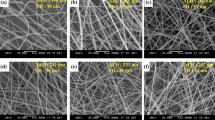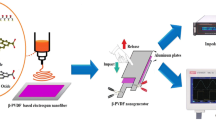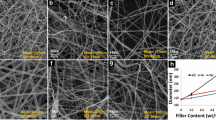Abstract
In this study, piezoelectric performance of polyvinylidene fluoride (PVDF) is enhanced by facile blending with aromatic hyperbranched polyester of 1st generation (Ar.HBP-G1). Prior to blending with PVDF, Ar.HBP-G1 was synthesized by one-shot polycondensation technique using pentaerythritol (as core) and diphenolic acid (as AB2 type monomer), and analyzed by different spectroscopic (FTIR-ATR, NMR) techniques. PVDF with varying Ar.HBP-G1 content (0, 10, 20, 30 and 40 wt.-%) were blended to obtain electrospun fibers, and their morphology examined by FE-SEM and crystallization behavior analyzed using FTIR and XRD. As-prepared electrospun PVDF/Ar.HBP-G1 composite nanofibers (NFs) were used to fabricate piezoelectric nanogenerator (PENG) using Ni-Cu coated conductive fabric as electrodes. Piezoelectric performance was evaluated by employing a periodic load of 1.0 kgf at a constant frequency of 1.0 Hz. Among the five different PENG samples used in our study, the peak-to-peak output voltage (Vp-p) for PVDF-Ar.HBP-G1 (10 wt.-%) NF showed almost three times (4.28 V) better piezoelectric response compared to neat PVDF (1.89 V). The optimized sample (Ar.HBP-G1 (10 wt.-%)) subjected to varying load (1 to 3 kgf) and frequency (0.1 to 1.0 Hz) showed maximum Vp-p of 4.28 V under 1 kgf and 1.0 Hz. Further, the PENG was employed for portable and human health monitoring energy harvesting applications.








Similar content being viewed by others
Data availability
Data will be made available at a reasonable request.
References
Tang W, Jiang T, Fan FR et al (2015) Liquid-metal electrode for high-performance triboelectric nanogenerator at an instantaneous energy conversion efficiency of 70.6%. Adv Funct Mater 25:3718–3725. https://doi.org/10.1002/adfm.201501331
Leng Q, Chen L, Guo H et al (2014) Harvesting heat energy from hot/cold water with a pyroelectric generator. J Mater Chem A 2:11940–11947. https://doi.org/10.1039/c4ta01782j
Yang J, Zhang C, Wang XD et al (2019) Development of micro- and nanorobotics: a review. Sci China Technol Sci 62. https://doi.org/10.1007/s11431-018-9339-8
Sultana A, Alam MM, Ghosh SK et al (2019) Energy harvesting and self-powered microphone application on multifunctional inorganic-organic hybrid nanogenerator. Energy 166:963–971. https://doi.org/10.1016/j.energy.2018.10.124
Alluri NR, Saravanakumar B, Kim SJ (2015) Flexible, hybrid piezoelectric film (BaTi(1–x)ZrxO3)/PVDF nanogenerator as a self-powered fluid velocity sensor. ACS Appl Mater Interfaces 7:9831–9840. https://doi.org/10.1021/acsami.5b01760
Arroyo E, Badel A (2011) Electromagnetic vibration energy harvesting device optimization by synchronous energy extraction. Sens Actuators A Phys 171:266–273. https://doi.org/10.1016/j.sna.2011.06.024
Khan FU, Qadir MU (2016) State-of-the-art in vibration-based electrostatic energy harvesting. J Micromechanics Microengineering 26:103001. https://doi.org/10.1088/0960-1317/26/10/103001
Sultana A, Ghosh SK, Sencadas V et al (2017) Human skin interactive self-powered wearable piezoelectric bio-e-skin by electrospun poly-l-lactic acid nanofibers for non-invasive physiological signal monitoring. J Mater Chem B 5:7352–7359. https://doi.org/10.1039/c7tb01439b
Gajula P, Muhammad FM, Reza MS et al (2023) Fabrication of a silicon elastomer-based self-powered flexible triboelectric sensor for wearable energy harvesting and biomedical applications. ACS Appl Electron Mater 5:1750–1760. https://doi.org/10.1021/acsaelm.2c01773
Chen X, Li X, Shao J et al (2017) High-performance piezoelectric nanogenerators with imprinted P(VDF-TrFE)/BaTiO3 Nanocomposite Micropillars for Self-Powered Flexible Sensors. Small 13:1–12. https://doi.org/10.1002/smll.201604245
Chen X, Shao J, An N et al (2015) Self-powered flexible pressure sensors with vertically well-aligned piezoelectric nanowire arrays for monitoring vital signs. J Mater Chem C 3:11806–11814. https://doi.org/10.1039/c5tc02173a
Chen X, Parida K, Wang J et al (2017) A stretchable and transparent nanocomposite nanogenerator for self-powered physiological monitoring. ACS Appl Mater Interfaces 9:42200–42209. https://doi.org/10.1021/acsami.7b13767
Shi K, Sun B, Huang X, Jiang P (2018) Synergistic effect of graphene nanosheet and BaTiO3 nanoparticles on performance enhancement of electrospun PVDF nanofiber mat for flexible piezoelectric nanogenerators. Nano Energy 52:153–162. https://doi.org/10.1016/j.nanoen.2018.07.053
Maity K, Garain S, Henkel K et al (2020) Self-powered human-health monitoring through aligned PVDF nanofibers interfaced skin-interactive piezoelectric sensor. ACS Appl Polym Mater 2:862–878. https://doi.org/10.1021/acsapm.9b00846
Ju M, Dou Z, Li J-W, Qiu X, Shen B, Zhang D, Yao F-Z, Gong W, Wang K (2023) Piezoelectric materials and sensors for structural health monitoring: fundamental aspects, current status, and future perspectives. Sensors 23(1):543. https://doi.org/10.3390/s23010543
Anand A, Meena D, Dey KK, Bhatnagar MC (2020) Enhanced piezoelectricity properties of reduced graphene oxide (RGO) loaded polyvinylidene fluoride (PVDF) nanocomposite films for nanogenerator application. J Polym Res 27:358. https://doi.org/10.1007/s10965-020-02323-x
Kumar M, Kumari P, Sahatiya P (2022) P(VDF-TrFE)/ZnO nanofiber composite based piezoelectric nanogenerator as self-powered sensor: fabrication and characterization. J Polym Res 29:44. https://doi.org/10.1007/s10965-022-02890-1
Kulkarni ND, Kumari P (2023) Role of rGO on mechanical, thermal, and piezoelectric behaviour of PVDF-BTO nanocomposites for energy harvesting applications. J Polym Res 30:79. https://doi.org/10.1007/s10965-023-03449-4
Cao X, Xiong Y, Sun J et al (2021) Piezoelectric nanogenerators derived self-powered sensors for multifunctional applications and artificial intelligence. Adv Funct Mater 31:2102983. https://doi.org/10.1002/adfm.202102983
Zeyrek M, Oguzlar S, Kartal U, Yurddaskal M (2021) Energy harvesting nanogenerators : Electrospun β-PVDF nanofibers accompanying ZnO NPs and ZnO @ Ag NPs. Solid State Sci 122:106772. https://doi.org/10.1016/j.solidstatesciences.2021.106772
Liu Q, Wang X-X, Song W-Z et al (2020) Wireless single-electrode self-powered piezoelectric sensor for monitoring. ACS Appl Mater Interfaces 12:8288–8295. https://doi.org/10.1021/acsami.9b21392
Guo W, Tan C, Shi K et al (2018) Wireless piezoelectric devices based on electrospun PVDF/BaTiO3 NW nanocomposite fibers for human motion monitoring. Nanoscale 10:17751–17760. https://doi.org/10.1039/C8NR05292A
Prasad G, Graham SA, Yu JS et al (2023) Investigated a PLL surface-modified Nylon 11 electrospun as a highly tribo-positive frictional layer to enhance output performance of triboelectric nanogenerators and self-powered wearable sensors. Nano Energy 108:108178. https://doi.org/10.1016/j.nanoen.2023.108178
Gajula P, Muhammad FM, Reza MS et al (2023) Fabrication of a silicon elastomer-based self-powered flexible triboelectric sensor for wearable energy harvesting and biomedical applications. ACS Appl Electron Mater. https://doi.org/10.1021/acsaelm.2c01773
Gunasekhar R, Sathiyanathan P, Reza MS, Prasad G, Prabu AA, Kim H (2023) Polyvinylidene fluoride/aromatic hyperbranched polyester of third-generation-based electrospun nanofiber as a self-powered triboelectric nanogenerator for wearable energy harvesting and health monitoring applications. Polymers. 15(10):2375. https://doi.org/10.3390/polym15102375
Avanish Babu T, Madhuri W (2022) A hybrid microwave sintered PZT composite as a flexible piezoelectric nanogenerator. RSC Adv 12:34454–34462. https://doi.org/10.1039/d2ra05570h
Cha SN, Seo JS, Kim SM et al (2010) Sound-driven piezoelectric nanowire-based nanogenerators. Adv Mater 22:4726–4730. https://doi.org/10.1002/adma.201001169
Xu S, Hansen BJ, Wang ZL (2010) Piezoelectric-nanowire-enabled power source for driving wireless microelectronics. Nat Commun 1. https://doi.org/10.1038/ncomms1098
Li Z, Zhu G, Yang R et al (2010) Muscle-driven in vivo nanogenerator. Adv Mater 22:2534–2537. https://doi.org/10.1002/adma.200904355
Xu S, Qin Y, Xu C et al (2010) Self-powered nanowire devices. Nat Nanotechnol 5:366–373. https://doi.org/10.1038/nnano.2010.46
Hu Y, Zhang Y, Xu C et al (2010) High-output nanogenerator by rational unipolar assembly of conical nanowires and its application for driving a small liquid crystal display. Nano Lett 10:5025–5031. https://doi.org/10.1021/nl103203u
Zhu G, Yang R, Wang S, Wang ZL (2010) Flexible high-output nanogenerator based on lateral ZnO nanowire array. Nano Lett 10:3151–3155. https://doi.org/10.1021/nl101973h
Il Park K, Xu S, Liu Y et al (2010) Piezoelectric BaTiO3 thin film nanogenerator on plastic substrates. Nano Lett 10:4939–4943. https://doi.org/10.1021/nl102959k
Li Z, Wang ZL (2011) Air/liquid-pressure and heartbeat-driven flexible fiber nanogenerators as a micro/nano-power source or diagnostic sensor. Adv Mater 23:84–89. https://doi.org/10.1002/adma.201003161
Stassi S, Cauda V, Ottone C et al (2015) Flexible piezoelectric energy nanogenerator based on ZnO nanotubes hosted in a polycarbonate membrane. Nano Energy 13:474–481. https://doi.org/10.1016/j.nanoen.2015.03.024
Yang Y, Guo W, Pradel KC et al (2012) Pyroelectric nanogenerators for harvesting thermoelectric energy. Nano Lett 12:2833–2838. https://doi.org/10.1021/nl3003039
Gunasekhar R, Prabu AA (2023) Polyvinylidene fluoride/aromatic hyperbranched polyester 2nd generation based triboelectric sensor for polysomnographic and health monitoring applications. Sens Actuators A Phys 114311. https://doi.org/10.1016/j.sna.2023.114311
Sathiyanathan P, Dhevi DM, Prabu AA, Kim KJ (2019) Electrospun polyvinylidene fluoride-polyoctafluoropentyl acrylate-hydroxyapatite blend based piezoelectric pressure sensors. Macromol Res 743–749. https://doi.org/10.1007/s13233-019-7116-2
Sathiyanathan P, Prabu AA, Kim KJ (2016) Electrospun polyvinylidene fluoride-polyoctafluoropentyl acrylate blend based piezocapacitive pressure sensors. Macromol Res 24:670–674. https://doi.org/10.1007/s13233-016-4098-1
Sathiyanathan P, Wu L, Schmidt TW et al (2021) Piezoelectric-piezocapacitive hybrid sensor based on electrospun Poly (vinylidene fluoride)-Poly (octafluoropentyl acrylate)-sulphonated Poly (phenylene sulfide) blend nanofiber. Sens Actuators A Phys 331:112993. https://doi.org/10.1016/j.sna.2021.112993
Prasad G, Sathiyanathan P, Prabu AA, Kim KJ (2017) Piezoelectric characteristics of electrospun PVDF as a function of phase-separation temperature and metal salt content. Macromol Res 25:981–988. https://doi.org/10.1007/s13233-017-5127-4
Alam MM, Sultana A, Mandal D (2018) Biomechanical and acoustic energy harvesting from TiO2 nanoparticle modulated PVDF nanofiber made high performance nanogenerator. ACS Appl Energy Mater 1:3103–3112. https://doi.org/10.1021/acsaem.8b00216
Zhang X, Tong J, Zhu H et al (2017) Room temperature magnetoresistance effects in ferroelectric poly(vinylidene fluoride) spin valves. J Mater Chem C 5:5055–5062. https://doi.org/10.1039/c7tc00517b
Biswas A, Henkel K, Schmeißer D, Mandal D (2017) Comparison of the thermal stability of the α, β and γ phases in poly(vinylidene fluoride) based on in situ thermal Fourier transform infrared spectroscopy. Phase Transitions 90:1205–1213. https://doi.org/10.1080/01411594.2017.1337902
Chang C, Tran VH, Wang J et al (2010) Direct-write piezoelectric polymeric nanogenerator with high energy conversion efficiency. Nano Lett 10:726–731. https://doi.org/10.1021/nl9040719
Lee EJ, Kim TY, Kim SW et al (2018) High-performance piezoelectric nanogenerators based on chemically-reinforced composites. Energy Environ Sci 11:1425–1430. https://doi.org/10.1039/c8ee00014j
Moorthy B, Baek C, Wang JE et al (2017) Piezoelectric energy harvesting from a PMN-PT single nanowire. RSC Adv 7:260–265. https://doi.org/10.1039/c6ra24688e
Sarker MRH, Karim H, Martinez R et al (2015) Temperature measurements using a lithium niobate (LiNbO3) pyroelectric ceramic. Meas J Int Meas Confed 75:104–110. https://doi.org/10.1016/j.measurement.2015.07.044
Manjula Dhevi D, Jaisankar SN, Pathak M (2013) Effect of new hyperbranched polyester of varying generations on toughening of epoxy resin through interpenetrating polymer networks using urethane linkages. Eur Polym J 49:3561–3572. https://doi.org/10.1016/j.eurpolymj.2013.06.041
Dhevi DM, Anand Prabu A, Kim KJ (2016) Hyperbranched polyester as a crosslinker in polyurethane formation: real-time monitoring using in situ FTIR. Polym Bull 73:2867–2888. https://doi.org/10.1007/s00289-016-1629-z
Gunasekhar R, Manjula Dhevi D, Ponnan S, Anand Prabu A (2022) Synthesis of aromatic hyperbranched polymer based on diphenolic acid and pentaerythritol: reaction kinetics using FTIR technique. ECS Trans 107:11137–11144. https://doi.org/10.1149/10701.11137ecst
Yang T, Pan H, Tian G et al (2020) Hierarchically structured PVDF/ZnO core-shell nanofibers for self-powered physiological monitoring electronics. Nano Energy 72:104706. https://doi.org/10.1016/j.nanoen.2020.104706
Acknowledgements
The authors are grateful to Prof. Hongdoo Kim and Prof. Kap Jin Kim, Kyung Hee University, Republic of Korea for providing the piezoelectric measurement facility and to Dr. Mohammad Shamim Reza for assisting the piezoelectric measurements in their facility.
Funding
The research leading to these results received funding from CSIR, Government of India CSIR-EMR-II scheme (03(1450)18/EMR-II dt.05-06-2018).
Author information
Authors and Affiliations
Corresponding author
Ethics declarations
Conflicts of interest
The authors declare that they have no known competing financial interests or personal relationships that could have appeared to influence the work reported in this paper.
Additional information
Publisher's Note
Springer Nature remains neutral with regard to jurisdictional claims in published maps and institutional affiliations.
Supplementary information
Below is the link to the electronic supplementary material.
Rights and permissions
Springer Nature or its licensor (e.g. a society or other partner) holds exclusive rights to this article under a publishing agreement with the author(s) or other rightsholder(s); author self-archiving of the accepted manuscript version of this article is solely governed by the terms of such publishing agreement and applicable law.
About this article
Cite this article
Gunasekhar, R., Prabu, A.A. Fabrication of 1st generation aromatic hyperbranched polyester/ polyvinylidene fluoride blended electrospun composites to enrich the piezoelectric performance. J Polym Res 30, 287 (2023). https://doi.org/10.1007/s10965-023-03675-w
Received:
Accepted:
Published:
DOI: https://doi.org/10.1007/s10965-023-03675-w




